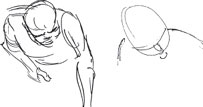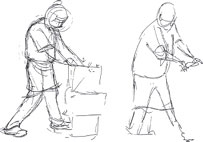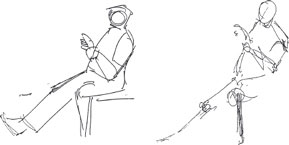136 Words That Help in Drawing
How important are words in drawing? In a sense we think with words, and communicate our thoughts in words. In animation the first stage of a cartoon is entirely in word form (the story). Then the story-sketch artists transpose those words into drawings in the form of storyboards (overly simplified version of the procedure, I agree), and then the animators carry it further into full animation. The dialog and descriptions that communicate the meaning of the story must be exact, simple (though often deep), explicit, and clear to all who are involved. Otherwise the picture might end up like one of comedian Gracie Allen’s conversations.
Much of the material is open to interpretation by the director and/or animator. For instance, a scene description in Aristocrats goes: “Two shot — Marie and Berlioz still enjoying the situation.” The situation — is that Berlioz had just called the butler, Edgar, an “Old pickle puss.” The animator (Stanchfield) chose to make it a one-shot with Berlioz cracking up on the floor, rolling on his back in glee with Marie’s dialog offstage. Here are three drawings from the scene.
![]()
Without having a feeling for the situation and without first putting it all into words, like, “I’ll make it a close-up of Berlioz rocking back and forth on his back,” how could I have possibly made a drawing? Of course there were other considerations. I figured this would be clearer without Marie delivering the dialog on stage. Besides we saw her in last scene, and a close-up of Berlioz would be cute and add some pizzazz. Once I got those words settled in my mind the rest was easy.
What am I leading up to? I’m leading up to drawing from the model without selecting some appropriate words to describe the action or story you’re about to interpret in your sketch. Without them your efforts are apt to be reduced to mere copying. The other night we were fortunate to have Craig Howell as our model. He is a living storyboard. He studies the label on a bottle, he holds a hot dish with his apron, and he twists a pepper mill so realistically that Roger Chaisson sneezed.
Here are some drawings from that session. The first correction was made essentially to get the artist to look for a simpler approach to drawing an action. Too many ruffles without a good basic abstract shape will interfere with the flow of action. In addition to a simpler shape, I had the character push down more with the pepper mill and strengthened the look as if he were willing the pepper to land in a particular place. You can almost see the ground pepper shooting out.

Here is another drawing where the model is so intent on smashing a cockroach it requires that he bend into the fray in a more aggressive manner — the key words being bend forward. As in tennis, you step into the ball, otherwise you get caught hitting the ball while backing up and off balance. (I knew you’d want to know that).

Here’s a drawing that was hard to pin down in words, so I concentrated on the look — one of the most important actions in drawing. I tucked in the character’s right shoulder and turned the other side into a bent back and this opened up a passage for the look to travel in. Notice how the right shoulder helps start the action and the left side helps to jettison the look on its way.

Here’s another example of bending into the action. The artist tried to get a bend in the drawing but failed to bend at the waist. Actually, bending at the waist is hard to draw. Bending at the hips is simpler and clearer. Stand up and try it — your feet stay where they are, your rump goes out back yonder, your head goes forward, and everything is in balance. Now try to bend at the waist. It’s not a clear move is it? When a character is doing something like this, I like to think of that area between his face and his hands, and between his two arms as a stage. That is where the story is taking place. I lowered the right elbow slightly to open up the stage and tipped the hands slightly to better show what is taking place there. In other words, I staged it so the action (story) was clearer.

In this next correction I was suggesting that the artist concentrate on the action. Say to yourself “Guy standing there grinding out some pepper.” Those are some words that suggest the simplest and most direct route to put over the idea. Actually, with words (and the ensuing word-picture), the drawing will more easily fall into place.

One more and I’ll let you get back to work. Here we go again straightening things up, and consequently stiffening things up. Enter into the spirit of the thing and say “The guy’s looking at something. I’ll lower the near shoulder, twist the body toward me to open up that ‘stage’ (I mentioned earlier). Also I’ll drop the knee of the right leg a little lower because of that leg’s angle to the floor.”

This all may sound like a cerebral and emotional nightmare, but not so. Thinking is only stressful when it has to do with income tax, divorces, and finding your keys. Figuring these things out in drawing is pure fun. Do you hear me? FUN.
Here are some of Mike Swofford’s drawings. I had no suggestions on these for they are highly personal interpretations of the poses. At the beginning of the session he found himself copying the model, so he made a special effort to break away from that. Mike usually leans toward the cartoony side of drawing, so there is a delightfully whimsical quality to them.

